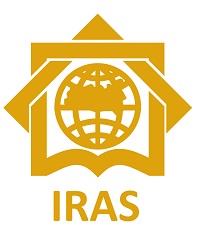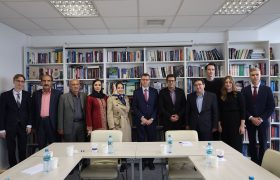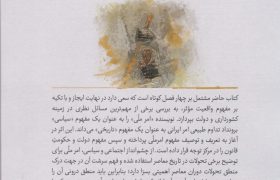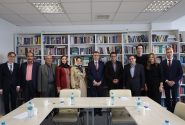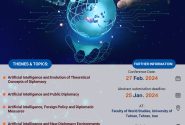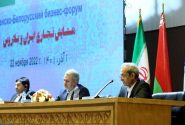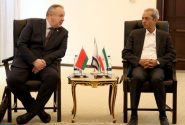The Eighth Joint Meeting of the Iranian Studies Scientific Association and the Institute for Iran-Eurasia Studies (IRAS) was held under the theme “Iranian Studies in Armenia: Challenges and Future Prospects” at IRAS. The meeting was chaired by Mahmoud Jafari Dehaghi, President of the Iranian Studies Scientific Association, with Gorgen Melkonyan, Seyed Hossein Tabatabaei, Vardan Voskanyan, Andranik Simonyan, and Majid Karimi as the keynote speakers.
Jafari Dehaghi, in his opening remarks, emphasized Iran’s rich civilization and described the three-thousand-year cultural, emotional, and political ties between Iran and Armenia as unparalleled. He noted: “The cultural and political bonds between Iranians and Armenians have continued from the Parthian and Achaemenid periods to the present. Many historians have considered this deep relationship as being rooted in the influence of Persian literature on Armenian literary traditions.”

He further added: “The impact of the deities Anahita and Ahura Mazda on Armenian culture, as well as the enduring influence of Persian poets such as Khayyam and Ferdowsi, cannot be overlooked. Armenian archaeologists have preserved invaluable manuscripts and texts through their research. Since ancient times, Armenians have translated Hafez’s poetry into Armenian and staged hundreds of plays based on Ferdowsi’s Shahnameh. These contributions stand as major services of Armenian scholars to the field of Iranian Studies.”
Jafari Dehaghi also announced the preparation of a new project aimed at identifying foreign centers of Iranian Studies, beginning with an assessment of the discipline’s challenges in Armenia.

Next, Gorgen Melkonyan from Yerevan University highlighted the shared cultural symbolism of Rustam, the legendary Iranian hero, in both Iranian and Armenian traditions: “Rustam, born from Iran’s cultural and epic heritage, represents a common historical and civilizational link between Iranians and Armenians. Ferdowsi’s monumental Shahnameh enjoys wide readership in Armenia, with partial translations published in Shushi.” He praised prominent Armenian scholars and Iranologists, calling them “the pride of Armenia.”
Melkonyan also stressed the potential of Yerevan University’s Iranian Studies faculty, stating that through joint collaborations with Iranian universities such as Tehran University and Allameh Tabatabaei University, opportunities for systematic and purposeful research projects could be developed—strengthening cultural, political, and emotional ties between the two countries. He concluded by reciting verses from Rumi.
Seyed Hossein Tabatabaei, in his speech, underlined the inseparable ties of the two nations: “For Armenians, Iranian Studies is part of self-knowledge. From ancient times, deep religious, linguistic, and cultural commonalities have existed between the two peoples. Since 1919, Armenia’s Faculty of Oriental and Iranian Studies has led this field, remaining one of the most significant academic centers even after the collapse of the Soviet Union.”
He highlighted the importance of Persian manuscripts preserved in Armenia and noted: “Today, over 25 schools in Armenia teach Persian as a compulsory subject. Clear and fluent translations of Persian works continue to be published, and Armenian students now read Iranian authors such as Nader Ebrahimi alongside world literary figures like Anton Chekhov and Maxim Gorky.”

Tabatabaei identified imbalances in research focus: “Most theses and studies are devoted to Iranian ethnic groups, dialects, and languages, while Persian literary theory and academic approaches to Persian literature have received less attention. Although seminars on works such as Dr. Shafi’i Kadkani’s Periods of Persian Poetry have been held, broader attention is lacking. Political and geopolitical issues often outweigh cultural topics, especially after disputes concerning Qaradag, Azerbaijan, and Turkey.”
He also pointed out the fragmentation within the Armenian Iranology community: “Universities such as Yerevan University collaborate with Cambridge University, but similar partnerships with Tehran and Allameh Tabatabaei Universities are absent.”
Vardan Voskanyan, reflecting on Armenian historiography since the 5th century, stressed Armenia’s appreciation for Iranian Studies, Shia Studies, and ethnology. He emphasized the contributions of Armenian historians and Iranologists who not only translated and compiled works but also founded schools dedicated to Oriental and Iranian Studies. He cautioned that in some contexts, Iran’s image has been unfairly distorted.

Andranik Simonyan, acknowledging Professor Melkonyan’s efforts to promote Iranian culture, highlighted the profound cultural ties: “Comparative literature has expanded, and Oriental Studies in Armenia now adopt different perspectives from those in Europe. We see a shared 3,000-year heritage reflected in rituals and festivals such as fire worship, Chaharshanbe Suri, Tirgan, Nowruz, Mehrgan, and Sadeh, which demonstrate deep cultural and spiritual bonds between our nations.”
He emphasized the urgent need for new joint research initiatives: “We must now examine emerging cultural commonalities.”
Finally, Dr. Karimi, by presenting historical inscriptions, manuscripts, and monuments as evidence of shared heritage, called for joint programs between the universities of the two countries.

